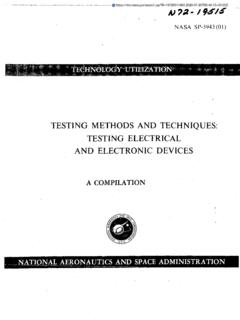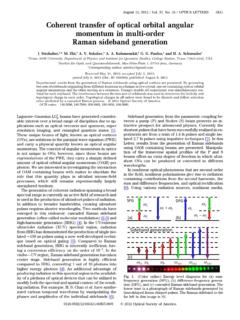Transcription of Frequency-tunable Pre-Stabilized lasers for LISA via ...
1 Frequency-tunable Pre-Stabilized lasers for LISA via sideband -locking J C Livas1, J I Thorpe1, K Numata1,2, S Mitryk3, G Mueller3, and V Wand3 1 NASA Goddard Space Flight Center, 8800 Greenbelt Road, Greenbelt, MD 20771 USA 2 Department of Astronomy, University of Maryland, College Park, MD 20742 USA 3 Department of Physics, University of Florida, Gainesville, FL 32611 USA E-mail: Abstract. laser frequency noise mitigation is one of the most challenging aspects of the LISA interferometric measurement system. The unstabilized frequency fluctuations must be suppressed by roughly twelve orders of magnitude in order to achieve stability sufficient for gravitational wave detection.
2 This enormous suppression will be achieved through a combination of stabilization and common-mode rejection. The stabilization component will itself be achieved in two stages: pre-stabilization to a local optical cavity followed by arm-locking to some combination of the inter-spacecraft distances. In order for these two stabilization stages to work simultaneously, the lock-point of the pre-stabilization loop must be frequency tunable . The current baseline stabilization technique, locking to an optical cavity, does not provide tunability between cavity resonances, which are typically spaced by 100s of MHz.
3 Here we present a modification to the traditional Pound-Drever-Hall cavity locking technique that allows the laser to be locked to a cavity resonance with an adjustable frequency offset. This technique requires no modifications to the optical cavity itself, thus preserving the stability of the frequency reference. We present measurements of the system performance and demonstrate that we can meet implement the first two stages of stabilization. 1. Introduction The LISA instrument detects gravitational waves by measuring the differential separation between widely separated spacecraft using a rotating triangular system of three spacecraft [1].
4 As in any interferometer, the differential length measurement will be sensitive to laser frequency fluctuations unless the path lengths of the interfering arms are identical. The LISA spacecraft are in independent orbits, so it is not possible to make the separation between each spacecraft identical even in principle. Therefore, it is necessary to actively reduce the product of the relative frequency noise and the worst case path length difference to a level comparable to the required strain sensitivity.
5 The current baseline design proposes to accomplish the frequency noise reduction using a 3-step process: pres-stabilization, arm-locking, and time-delay interferometry (TDI) [2]. The allocation of required performance among these three methods is not unique. Figure 1 shows one example of how the different methods might be used to get the required level of stability. / () x 10 21 The present plan is to use these different stabilization methods in series with a set of nested control loops. Pre-stabilization of the free-running laser to a frequency reference such as a cavity means that the center frequency of the laser is then locked to one of a range of discrete values characteristic of the reference and separated by the free-spectral range (FSR) of the cavity, typically several x 100 MHz.
6 When it becomes 1 2020-07-03T18:00:15+00:00 ZFrequency- tunable Pre-Stabilized lasers for LISA via sideband -locking 2 necessary to transfer the Pre-Stabilized laser to the next level of reference, as for example with arm-locking, it is necessary to tune the center frequency of the laser to match the new reference. The tunability required for this application is relatively narrow since even a 1 GHz change in the carrier frequency is a fractional change of only 3 parts per million. Put another way, a one nm wavelength shift corresponds to 265 GHz at the center wavelength of the LISA laser (1064 nm).
7 Figure 1. Example of one way to achieve the required frequency stability using pre-stabilization, arm-locking, and TDI. 2. Offset locking techniques Tunability options There are a number of ways to make a laser tunable over a narrow band. The ideal method would allow a large frequency offset while preserving the frequency stability of the non- tunable source. In general a method of adjustment for the frequency is also a conduit for noise to enter the system, so it is important to understand the potential noise sources to minimize the introduction of noise.
8 In addition, for application to LISA it would be useful to be able to tune the laser at a high rate so that the frequency tuning capability could be used as a high bandwidth actuator in a control loop. Table 1 summarizes some of the possible methods. Table 1. laser frequency tuning methods. Tuning method Range Speed Advantages Disadvantages Acousto-Optic Modulator 10 s of MHz ~MHz Simple one device Low drive power efficiency Beam steering PZT on cavity mirror 100 s of MHz ~100 kHz Simple implementation Requires modified reference Offset Phase-locking 10 s of MHz ~ 10 kHz Simple implementation Requires an additional laser Offset sideband locking 10 s of GHz ~30 kHz No modification to the reference cavity Complex modulation spectrum Frequency-tunable Pre-Stabilized lasers for LISA via sideband -locking 3
9 Perhaps the simplest option is to use an acousto-optic modulator (AOM)[2]. Due to the nature of the physical mechanism for frequency shifting these devices tend to be inefficient in terms of their operating power requirements, and the frequency tuning process also steers the beam. Variations in pointing can cause noise when sampling the reference. For applications on the ground, there are techniques to minimize beam steering for example by optically double-passing the AOM crystal. For spaceflight, the additional complexity of the double-pass optics and the power inefficiency combine to make the AOM probably not the best choice.
10 A reference cavity can be made tunable by placing a device to change the spacing of the cavity, such as a PZT, between the cavity spacer and the end mirror. The main disadvantage of this approach is that it requires modification of the reference cavity, but good results have been obtained [4]. Another tuning method is to frequency stabilize a laser to a cavity and then phase lock another laser to the stabilized laser . The phase lock allows the second laser to run at a different frequency but retain the frequency stability of the first laser .



















